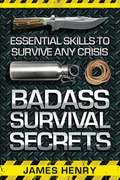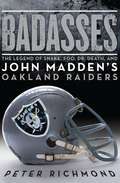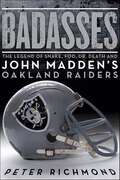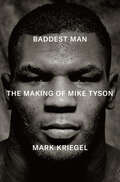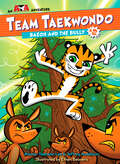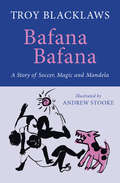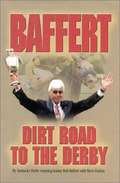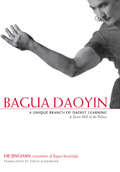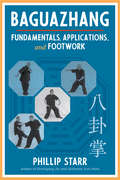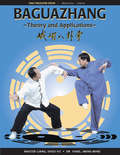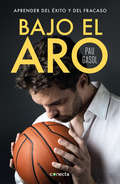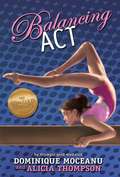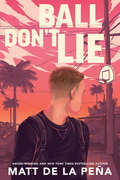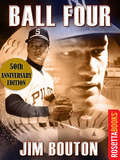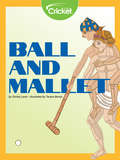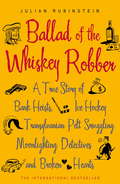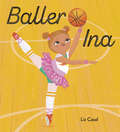- Table View
- List View
Badass Survival Secrets: Essential Skills to Survive Any Crisis
by James HenryHistory is filled with incredible stories of the mountain men, experts in survival who relied on nothing except their own skills and ingenuity. If you want to learn to be one of them, then this is the book for you. Badass Survival Secrets will introduce you to everything that you need to be a modern day mountain man. You'll learn how to construct shelter, build fires, how to track and hunt your food, how to find clean water, and how to stay warm in brutal climates. Everything that you need to become a badass survivalist expert is in this book.
Badasses: The Legend of Snake, Foo, Dr. Death, and John Madden's Oakland Raiders
by Peter RichmondCould a very good football team be more than just a very good football team? Could it be something more? Could it be legendary--not just Hall of Fame legendary but legendary as in the tales of ancient warriors, half-real and half-mythical, who mattered because they inspired people who needed to believe in figures mightier than their mundane selves? Could a football team seize the modern imagination because the days of true legend have long passed? Because we no longer have myths in sport or in life? Because long gone are the days when, as Ken Stabler put it to me, "you played for the name on the front of the jersey, not the name on the back"?
Badasses: The Legend of Snake, Foo, Dr. Death, and John Madden's Oakland Raiders
by Peter RichmondA book that explores the enduring legends of Snake, Foo, Dr. Death, and John Madden’s Oakland Raiders, Badasses is the definitive biography of arguably the last team to play old-fashioned tough-guy football. Peter Richmond, co-author of the New York Times bestseller The Glory Game, offers a fascinating look at the 1970s Oakland Raiders, led by colorful greats from another era: Ken Stabler, Willie Brown, Gene Upshaw, Jim Otto, Art Shell, head coach John Madden, and owner Al Davis. In the bestselling vein of Boys Will Be Boys, Badasses chronicles the bar-room exploits, practice-field pranks, and Super Bowl glories of the team’s many misfits, cast-offs, psychos, and geniuses of the game.
Baddest Man: The Making of Mike Tyson
by Mark KriegelFrom the acclaimed New York Times bestselling author whose coverage of Mike Tyson and his inner circle dates back to the 1980s, a magnificent noir epic about fame, race, greed, criminality, trauma, and the creation of the most feared and mesmerizing fighter in boxing history.On an evening that defined the "greed is good" 1980s, Donald Trump hosted a raft of celebrities and high rollers in a carnival town on the Jersey Shore to bask in the glow created by a twenty-one-year-old heavyweight champion. Mike Tyson knocked out Michael Spinks that night and in ninety-one frenzied seconds earned more than the annual payrolls of the Los Angeles Lakers' and Boston Celtics' players combined. It had been just eight years since Tyson, a feral child from a dystopian Brooklyn neighborhood, was delivered to boxing&’s forgotten wizard, Cus D&’Amato, who was living a self-imposed exile in upstate New York. Together, Cus and the Kid were an irresistible story of mutual redemption—darlings to the novelists, screenwriters, and newspapermen long charmed by D&’Amato, and perfect for the nascent industry of cable television. Way before anyone heard of Tony Soprano, Mike Tyson was HBO&’s leading man.It was the greatest sales job in the sport&’s history, and the most lucrative. But the business of Tyson concealed truths that were darker and more nuanced than the script would allow.The intervening decades have seen Tyson villainized, lionized, and fetishized—but never, until now, fully humanized. Mark Kriegel, an acclaimed biographer regarded as &“the finest boxing writer in America,&” was a young cityside reporter at the New York Daily News when he was first swept up in the Tyson media hurricane, but here he measures his subject not by whom he knocked out but by what he survived. Though Tyson was billed as a modern-day Jack Dempsey, in truth he was closer to Sonny Liston: Tyson was Black, feared, and born to die young. What made Liston a pariah, though, would make Tyson—in a way his own handlers could never understand—a touchstone for a generation raised on a soundtrack of hip hop and gunfire.What Peter Guralnick did for Elvis in Last Train to Memphis and James Kaplan for Sinatra in Frank, Kriegel does for Tyson. It&’s not just the dizzying ascent that he captures but also Tyson&’s place in the American psyche.
Badminton in Action
by Sarah Dann Niki WalkerBadminton may be known as a relaxing backyard game, but as the world's fastest racquet sport, it is action packed, thrilling, and very demanding.
Badminton: Steps to Success (2nd edition)
by Tony Grice"Players clocking shuttlecocks at speeds of 200 miles per hour, new scoring rules, and nonstop action make badminton one of the fastest racket sports in the world. With Badminton: Steps to Success you will learn the skills and tactics to excel at the highest level." "Through detailed, fully illustrated instruction, you will develop precision, power, and finesse as you use this step-by-step guide to master serves, forehands, backhands, clears, drop shots, smashes, drives, and more." "Badminton: Steps to Success also breaks down common errors players make and provides corrective techniques to pinpoint problems and improve execution. Over 100 drills will further enforce correct technique, with designated drills for tactical practice, conditioning, and teamwork for doubles play."--BOOK JACKET.
Baeoh and the Bully (Team Taekwondo #2)
by Jeffrey Nodelman Master Taekwon LeeBreak out your uniforms and tie your belts! In this Team Taekwondo graphic novel for kids, it's time to tackle bullying!ATA Team Taekwondo class clown Baeoh is excited for the dojo's Buddy Day! Normally, bringing a buddy to class would be all fun and laughs. But with a new bully in his life who won't leave him alone, Baeoh doesn't feel much like a buddy. Worse yet, he may be turning into a bully himself. Can Baeoh figure out how to turn this tough situation into a win?Baeoh and the Bully tackles how to deal with class bullies in a positive way. With plenty of humor and insight into the struggles children face, this installment is sure to be a fan favorite—passed from one reader to another.
Bafana Bafana: A Story of Soccer, Magic and Mandela
by Troy BlacklawsOne boy&’s journey to see his favorite soccer player in action becomes an uplifting song to the South African spirit A modern-day folktale set in the heart of South Africa, Bafana Bafana is the story of Pelé, an eleven-year-old village boy whose dream is to see his soccer team play. Such a dream is considered crazy for a boy from the distant outback, but Pelé is far from ordinary; determined to see his favorite player, Sibusiso Zuma, play live, Pelé treks hundreds of kilometers to the jostling, jiving Cape Town. From the dangers of townships, the incredible story of Nelson Mandela, and the magic of a local medicine man, Bafana Bafana is a joyous and lively tale about following your dreams, even in the face of daunting hurdles.
Baffert: Dirt Road to the Derby
by Steve Haskin Bob BaffertBaffert offers a frank--and frankly funny--portrayal of his border town roots and rapid rise to the top of the Sport of Kings, horse racing. A riveting and revealing tale of what it takes to become America's No. 1 trainer.
Bagua Daoyin: A Unique Branch of Daoist Learning, A Secret Skill of the Palace
by David Alexander Jinghan HeThe beautiful, complex movements of Bagua require a lifetime to master fully, but can be practised with significant physical and mental health benefit at any level. In this highly illustrated guide, Master He, a fifth generation practitioner, introduces the ancient Daoist principles on which Bagua is based, its place within the Chinese martial arts, and the approach to life it nurtures. Many pages of photographs illustrate a programme of sequences, showing the beauty of the movements, and the positions and transitions the practitioner is aiming for. Bagua Daoyin supports and trains the body and the mind to promote balance and harmony. The external movements are echoed in the internal body, which promotes the flow of energy that leads to greatly improved health, a tranquil and focused mind, and increased longevity. Practitioners quickly report reduced stress levels and increased enjoyment of life. This fully illustrated introduction to Bagua Daoyin will be essential reading for Bagua, Xingyi and Taiji practitioners at all levels, dancers, and indeed anyone interested in improving their physical and mental wellbeing.
Baguazhang: Fundamentals, Applications, and Footwork
by Phillip StarrA comprehensive guide to the fundamentals, sequences, and applications of Baguazhang.Baguazhang is unquestionably one of the most esoteric disciplines in martial arts. Based on the eight trigrams (bagua) of the Yi Jing, baguazhang emphasizes the importance of maneuverability, evasion, and change to deflect an aggressor's attacks. Unlike martial arts systems that employ overt punches, kicks, and grappling techniques, most of the bodily weapons of the baguazhang arsenal are well concealed, agile, and smooth. Utilizing deceptive forms of footwork and body shifting, the principles and techniques of Baguazhang will help readers develop a firm foundation and build a critical skill set for this unique martial art.Longtime martial arts practitioner and author Phillip Starr introduces readers to the fundamentals of baguazhang, showing how the movements of this enigmatic and widely misunderstood art can be practically applied in self-defense. Readers will learn: • Key baguazhang principles • Footholds • Basic stepping techniques, walking exercises, and postures • Proper alignments • "Mother palms," or basic exercises critical to the development of the "bagua body" Ideal for newcomers to baguazhang, this introduction elucidates the two foundational Single Change and Double Change Palms and offers a refresher for advanced practitioners looking to further explore applications for movements they already know.
Baguazhang: Theory and Applications
by Jwing-Ming Yang Shou-Yu LiangA COMPLETE TRAINING GUIDE FOR BEGINNER TO ADVANCED Packed with over nine hundred photographs, this comprehensive text offers theory, martial applications, sequences, Qigong exercises, weapon training, and is an indispensable resource for those serious about Chinese martial arts. *Translation of Ancient Baguazhang Documents *Baguazhang Turning and Spinning Qigong *Basic Training Hands, Feet, Posture, Stepping *Basic Training Two Person Routines *Body Conditioning with Weights and Poles *Body Conditioning Two Person Routines *Eight Palms Sequence and Martial Applications *Eight Palms Sequence Two-Person Fighting Set *Swimming Body Sequence and Martial Applications *Bagua Deer Hook Sword Sequence and Martial Applications Indisputably the most comprehensive book on Baguazhang in the English language.
Bajo el aro: Aprender del éxito y del fracaso
by Pau GasolUn libro que inspira a través del ejemplo y la reflexión. «Nadie dijo que fuera fácil alcanzar tus sueños. Pero si tienes una pasión verdadera y depositas todas tus esperanzas en ella, el esfuerzo para conseguirlos siempre te compensará», afirma Pau Gasol que, en Bajo el aro, comparte con los lectores los valores que le han llevado a lo más alto en su carrera deportiva y su trayectoria personal. No hay nada más bonito que poder desarrollar nuestro talento y hacerlo con pasión. Al hilo de su experiencia a lo largo de una espectacular carrera deportiva, en la que ha obtenido títulos pero también ha perdido finales, ha conocido victorias y derrotas sobre la bocina, ha vivido momentos con una forma excepcional y también la frustración de las lesiones, Pau Gasol comparte en Bajo el aro los principios y valores que le han convertido en un modelo a seguir. En este texto, muy personal, que inspira a través del ejemplo y la reflexión, Gasol aborda cómo el talento, el esfuerzo, el equilibrio o la necesidad de una reinvención permanente pueden aplicarse tanto al liderazgo y al emprendimiento deportivo o empresarial como a nuestro día a día. «Ahora, como cuando era pequeño, la pasión por jugar y por ganar sigue siendo mi motor. Cada día aprecio más lo afortunado que soy por tener el privilegio de amar lo que hago y al mismo tiempo poder inspirar a otros», afirma Paul Gasol compartiendo así su visión con una generosidad y empatía extraordinarias. Reseñas:«Siento un gran respeto por Pau Gasol, sobre todo por haber remontado lesiones graves con estoicismo y haber vuelto con más entusiasmo que nunca para demostrar que lo mejor estaba por venir. Y admiro su calidad humana, su nobleza, su entereza y su bondad, virtudes más grandes que él, ¡que ya es decir!»Plácido Domingo «Talento, esfuerzo, compromiso y, sobre todo, mucha pasión y liderazgo son los valores que Pau Gasol difunde en Bajo el aro. Su capacidad para inspirar y servir de modelo para los jóvenes es digna de elogio, porque el deporte es la puerta de entrada a la salud. Y la salud de los niños y las niñas es garantía de una sociedad futura mejor.»Valentí Fuster «Pau Gasol es un ejemplo para todos los deportistas españoles. Fue un pionero y ha triunfado en un país tan competitivo como Estados Unidos. Y los valores que representa son los que hay que transmitir dentro y fuera de las pistas de tenis o de baloncesto.»Rafa Nadal
Balancing Act
by Dominique Moceanu Alicia ThompsonTwelve-year-old Noelle Onesti has gymnastics in her blood. Not only does she have natural ability, talent and drive, but back in Romania, her mother was also an Elite gymnast. So if there's one girl destined to come home with a gold medal at the Junior National Championships, it's Noelle. But Noelle’s a worrier, and she knows it won’t be easy for her family to put up the money to send her to the competition. She tries to focus on her training, but when a boy asks her to the school dance, her mind is a whirlwind of dresses, crushes, and family responsibilities. Noelle knows that if she wants to achieve her Olympic dreams, she can’t let anything get in the way. Her teammates—graceful Christina, quiet Jessie, and lively Britt—can’t wait for the trip to Junior Nationals in Philadelphia, and Noelle doesn’t want to let them down.
Balancing Acts: Chalet Girls
by Emily FranklinThree teenaged girls try to prevent their secrets from interfering with their love lives and their goals as they work at Les Trois, an exclusive Alpine ski resort, over the winter.
Ball Buster (The Playbook #1)
by Kara SheridanIn Kara Sheridan's sexy new series, these hard-hitting pro footballers don't play by the book. Playbook Rule #1: Never ever give upIt's official. The Alabama Warriors have the worst reputation in pro football. As the team's captain, Carson Savage has his ass on the line and - thanks to a leaked photo - his ass is also online. Now the team is getting an image makeover from Sadie Reynolds, the hottest redhead in the South and Carson's high school sweetheart. Maybe making a play for his sexy ex is a risky move... but Carson didn't make it this far by playing it safe.Alabama is the last place in the world Sadie wants to be. Going home again only reminds her of what - and who - she gave up. Seeing the insanely hot ex she never quite forgot is dangerous. Carson's too sexy. Too tempting. And Sadie can't afford to go out of bounds. So she'll do whatever it takes to finish this job and leave town with her heart still intact. The only problem? Carson's decided it's not about winning the game... it's about winning the girl.The Playbook series: Ball BusterTight EndBig Jock
Ball Don't Lie
by Matt de la PeñaNewbery Award-winning author Matt de la Pena's Ball Don't Lie about basketball "is a must-read." [The Bulletin] <P> <P> Sticky is a beat-around-the-head foster kid with nowhere to call home but the street, and an outer shell so tough that no one will take him in. He started out life so far behind the pack that the finish line seems nearly unreachable. He's a white boy living and playing in a world where he doesn't seem to belong. But Sticky can ball. And basketball might just be his ticket out . . . if he can only realize that he doesn't have to be the person everyone else expects him to be. Matt de la Peña's breakout urban masterpiece, Ball Don't Lie takes place where the street and the court meet and where a boy can be anything if he puts his mind to it.
Ball Four
by Jim BoutonInsider's takes on baseball In 1963, Jim Bouton won 21 games for the Yankees. In 1964 he won 18 games for them, and two more in the World Series. Then Bouton lost his fast ball, and came to the gut-twisting decision to try to make it with the knuckleball -the most erratic and difficult pitch there is. Bouton got sent to the minors, fought his way back to the majors. Almost wrecked himself working on his knuckleball. Incited people. Made enemies. Made friends. Never gave up. And wrote a book. The biggest bestseller about the game of baseball, and the men who play it, ever published. "Here is Bouton as a day-to-day observer, hard thinker, marvellous listener, comical critic, angry victim and unabashed lover of a sport. What he has given us is a rare view of a complex public profession seen from the innermost side, along with an even more rewarding view of an ironic and courageous mind. And, very likely, the funniest book of the year."
Ball Four: The Final Pitch
by Jim BoutonWhen Ball Four was first published in 1970, it hit the sports world like a lightning bolt. Commissioners, executives, and players were shocked. Sportswriters called author Jim Bouton a traitor and ""social leper."" Commissioner Bowie Kuhn tried to force him to declare the book untrue. Fans, however, loved the book. And serious critics called it an important social document. Today, Jim Bouton is still not invited to Oldtimer's Days at Yankee Stadium. But his landmark book is still being read by people who don't ordinarily follow baseball. For the updated edition of this historic book, Bouton has written a new epilogue, detailing his perspective on how baseball has changed since the last edition was released.
Ball Four: The Final Pitch (RosettaBooks Sports Classics #1)
by Jim BoutonThe 50th Anniversary edition of &“the book that changed baseball&” (NPR), chosen by Time magazine as one of the &“100 Greatest Non-Fiction&” books. When Ball Four was published in 1970, it created a firestorm. Bouton was called a Judas, a Benedict Arnold, and a &“social leper&” for having violated the &“sanctity of the clubhouse.&” Baseball commissioner Bowie Kuhn tried to force Bouton to sign a statement saying the book wasn&’t true. Ballplayers, most of whom hadn&’t read it, denounced the book. It was even banned by a few libraries. Almost everyone else, however, loved Ball Four. Fans liked discovering that athletes were real people—often wildly funny people. David Halberstam, who won a Pulitzer for his reporting on Vietnam, wrote a piece in Harper&’s that said of Bouton: &“He has written . . . a book deep in the American vein, so deep in fact that it is by no means a sports book.&” Today Ball Four has taken on another role—as a time capsule of life in the sixties. &“It is not just a diary of Bouton&’s 1969 season with the Seattle Pilots and Houston Astros,&” says sportswriter Jim Caple. &“It&’s a vibrant, funny, telling history of an era that seems even further away than four decades. To call it simply a &‘tell all book&’ is like describing The Grapes of Wrath as a book about harvesting peaches in California.&” Includes a new foreword by Jim Bouton's wife, Paula Kurman &“An irreverent, best-selling book that angered baseball&’s hierarchy and changed the way journalists and fans viewed the sports world.&” —The Washington Post
Ball Games (Fountas & Pinnell Classroom, Guided Reading)
by Amy TichbourneNIMAC-sourced textbook. Bounce! What can you do with a ball?
Ball and Mallet
by Christy LenziTaribu and Riheti are an unlikely pair— Taribu is a slave while Riheti is a noble. Determined to prove themselves, they attend the New Year Festival to play a game of Ball and Mallet. Will Taribu be able to face his fears and help Riheti win the game?
Ballad of the Whiskey Robber: A True Story of Bank Heists, Ice Hockey, Transylvanian Pelt Smuggling, Moonlighting Detectives, and Broken Hearts
by Julian RubinsteinWhat do you get when you add together a bottle of whiskey, a bad gambler, a flea-market wig, a plastic gun and a Hungarian bank? $5,900. And what do you get twenty-nine of these robberies later? The legend of the Whiskey Robber. When the Eastern bloc thawed, some extraordinary stories were revealed. But none is as entertaining as this. Attila Ambrus escaped late-eighties Romania for Hungary - but soon found that living on his wits wasn't getting him very far. Becoming goalie for a third-division ice hockey team brought no fortune and little glory, and his procession of moneymaking ruses fared little better - until he discovered robbery. With a supporting cast of car-wash owners, exotic dancers, drunk army generals and cocaine-snorting Hungarian rappers, Julian Rubinstein's tale is a spectacular debut, immortalizing the most charming outlaw since the Sundance Kid.
Ballad of the Whiskey Robber: A True Story of Bank Heists, Ice Hockey, Transylvanian Pelt Smuggling, Moonlighting Detectives, and Broken Hearts
by Julian RubinsteinWhat do you get when you add together a bottle of whiskey, a bad gambler, a flea-market wig, a plastic gun and a Hungarian bank? $5,900. And what do you get twenty-nine of these robberies later? The legend of the Whiskey Robber. When the Eastern bloc thawed, some extraordinary stories were revealed. But none is as entertaining as this. Attila Ambrus escaped late-eighties Romania for Hungary - but soon found that living on his wits wasn't getting him very far. Becoming goalie for a third-division ice hockey team brought no fortune and little glory, and his procession of moneymaking ruses fared little better - until he discovered robbery. With a supporting cast of car-wash owners, exotic dancers, drunk army generals and cocaine-snorting Hungarian rappers, Julian Rubinstein's tale is a spectacular debut, immortalizing the most charming outlaw since the Sundance Kid.
Baller Ina
by Liz CasalSwish! Sure to be a slam-dunk at storytime, this rhyming picture book introduces readers to Ina, a graceful ballerina...who also loves to get competitive on the basketball court!Doesn&’t matter what you call her.Ballerina, basketballer. On the court or at the barre,Ina is a superstar! Ina loves to dance ballet: tendu, passé, and grand jeté. But there&’s more she can do in her pink tutu! Cheer from the sidelines as Ina--with her signature ballet moves--helps lead her basketball team to victory in this picture book that celebrates the marvelously multifaceted nature of kids.
